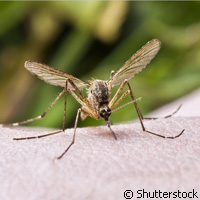Putting the lid on malaria
Scientists from the United Kingdom and the United States continue the good fight against malaria by working on control measures for mosquitoes that transmit this deadly disease. They say they can introduce a number of genetic alterations into extensive laboratory mosquito populations over the span of a few generations using a tiny number of modified mosquitoes. Their work is presented in the journal Nature. Researchers from Imperial College London in the United Kingdom and the University of Washington in the United States say this groundbreaking development could trigger a genetic alteration in a mosquito population, effectively hindering it from transmitting the malaria parasite, Plasmodium, to people. 'This is an exciting technological development, one which I hope will pave the way for solutions to many global health problems,' explains Professor Andrea Crisanti from the Department of Life Sciences at Imperial College London, one of the authors of the study. 'It demonstrates significant potential to control these disease-carrying mosquitoes. We expect to conduct many more experiments to determine its safety and reliability.' For the purposes of this study, the team bred mosquitoes with a green fluorescent gene, as it can be observed in the laboratory. They also made no restrictions on them, allowing them to move and reproduce with a small number of mosquitoes that carried a segment of deoxyribonucleic acid (DNA) coding for an enzyme able to permanently inactivate the fluorescent gene. The team counted the number of mosquitoes that retained an active fluorescent gene following each generation. The data show that in tests that started with close to 99% of green fluorescent mosquitoes, over 50% had lost their green marker genes in merely 12 generations. According to the researchers, this study is the first proof-of-principle experiment of its kind, and this tool could potentially be used to trigger a genetic change within a wild mosquito population. Over 300 million people are affected by malaria each year, and 800 000 lose the battle against this deadly disease. In Africa, malaria kills a child every 45 seconds. While public health experts seek eradication of this disease, they recognise that improved and cheaper tools are needed to ensure its eradication. 'Malaria is still a terrible disease,' comments Professor Austin Burt of Imperial College London, a senior author of the study. 'There are around 3 500 species of mosquito in the world, but only a few of them transmit the deadly malaria parasite, Plasmodium falciparum. This technology allows us to focus exclusively on controlling these most dangerous species.' Commenting on the results, Imperial College London's Dr Nikolai Windbichler and lead author says: 'In our mosquitoes the homing endonuclease gene is only passed on, through reproduction, directly to the carrier's offspring. This makes for a uniquely safe biological control measure that will not affect even very closely related mosquito species.' The next step for the researchers is to move from the synthetic fluorescent target used in their study to target genes that the mosquito needs to breed or to transmit malaria. Thanks to this technology, the release of a small number of altered mosquitoes could eventually result in a significant drop of the malaria-carrying mosquito population in nations that deal with this prevalent problem. Their work will continue in the INFRAVEC ('Research capacity for the implementation of genetic control of mosquitoes') project, which is supported with EUR 8.5 million under the Research Infrastructures budget line of the EU's Seventh Framework Programme (FP7). The INFRAVEC partners seek to close the gap between the latest advances in transgenic technology and its implementation as a new and strong approach for vector control.For more information, please visit: Imperial College Londonhttp://www3.imperial.ac.uk/Naturehttp://www.nature.com/
Countries
United Kingdom, United States

